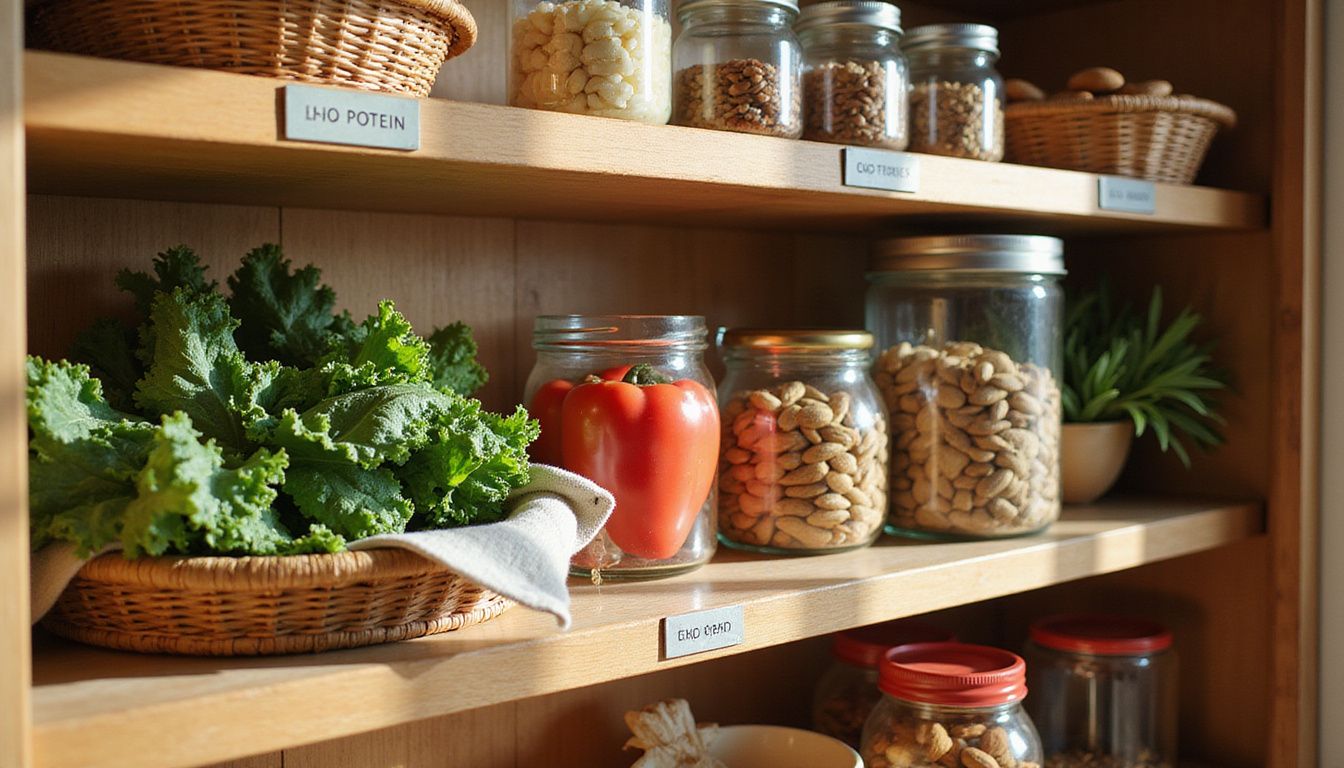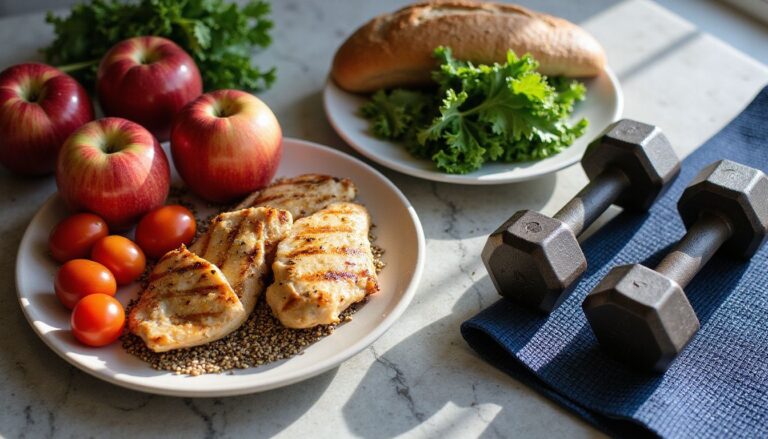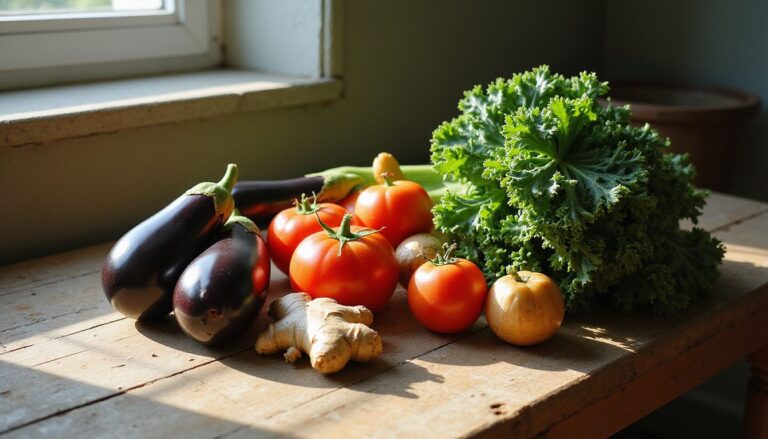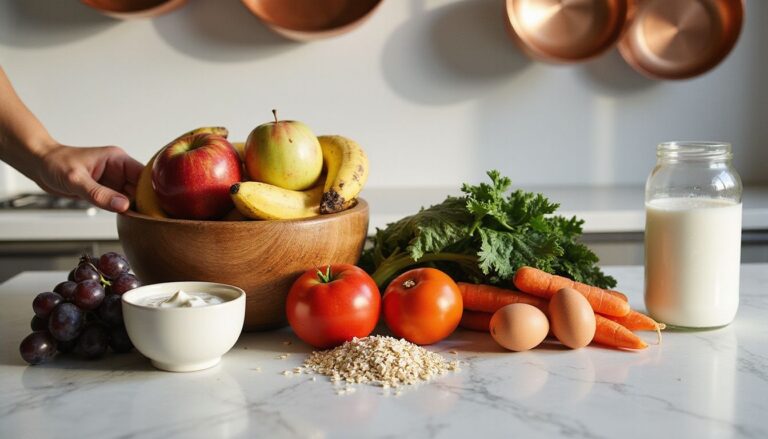No Carbs Diet Plan For 2 Weeks: Low Carb Meal Plan And Diet Guide
Our Nutrition Assistant AI Suite will transform your body. You will lose fat, get toned, and build muscle. Gain confidence and optimal health.
Want fast results and fewer cravings? A no-carb diet plan for 2 weeks can help you shift from burning sugar to burning fat. This low carb approach cuts almost all carbohydrate foods, including bread, pasta, rice, starchy vegetables, fruit, and beans, so your body relies on stored fat for energy.
In this guide, you will see what to eat, what to skip, smart meal prep tips, and easy recipes. You will also get snack ideas, a full 2-week outline, ways to track progress, and key risks to watch. If you wonder whether this plan can help you lose weight or improve blood sugar, you are in the right place.
Key Takeaways
- A strict no-carb plan removes nearly all carbs for two weeks to trigger ketosis, a fat-burning state.
- Many people lose 2 to 10 pounds in week one, mostly from water loss as glycogen drops.
- Meals focus on protein and fat, such as meat, fish, eggs, plain cheese, and oils like olive or coconut.
- No-carb diets may improve blood sugar in type 2 diabetes, but long use can raise the risk of constipation and nutrient gaps.
- Ask a healthcare professional before starting. Many dietitians suggest keeping some complex carbs for long-term health.
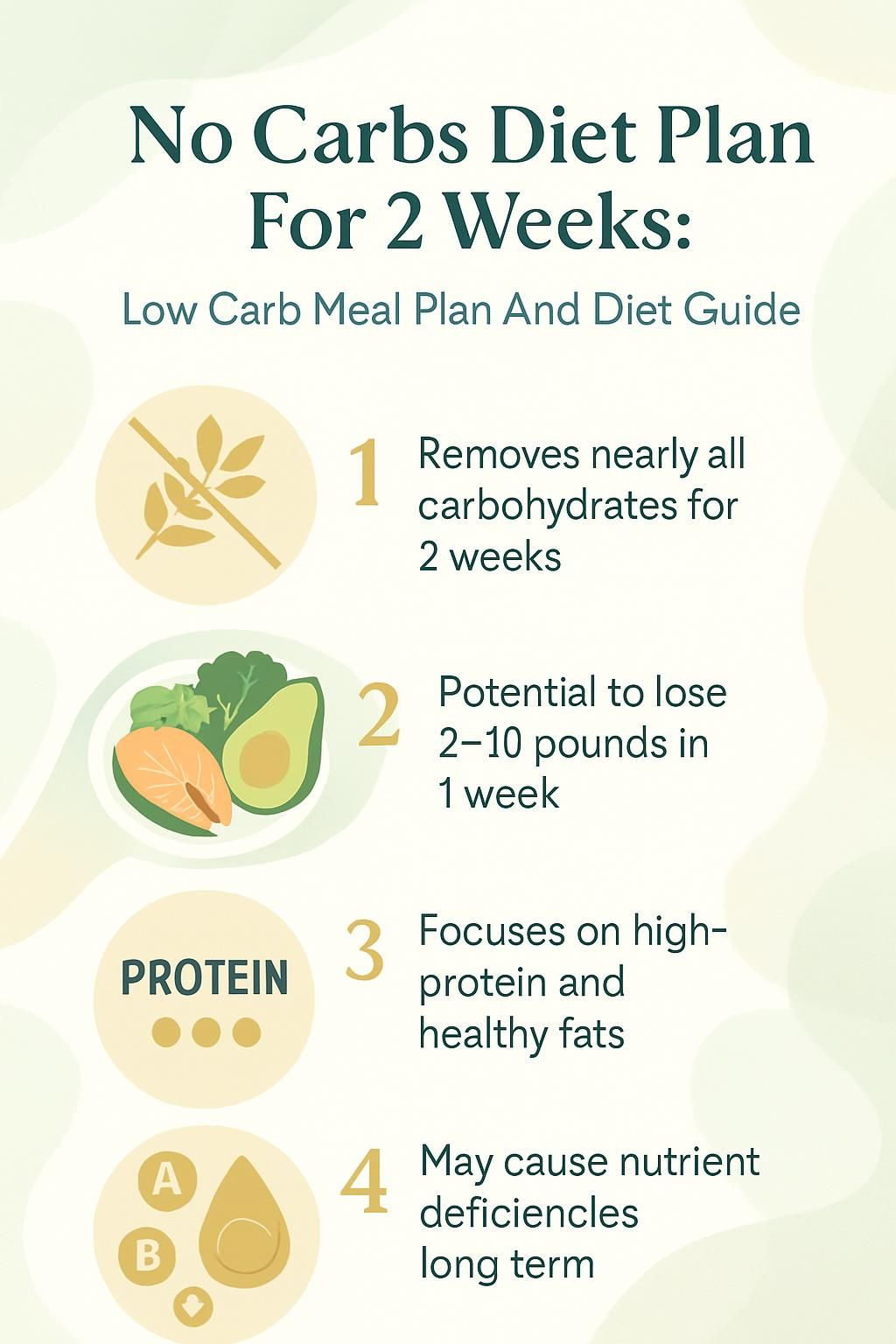
What is a No-Carb Diet?

A no-carb diet limits digestible carbohydrates to near zero. You build meals from protein and fat to meet your energy needs while keeping carbs almost completely out.
What does carbohydrate restriction mean?
Carbohydrate restriction means you remove nearly all foods that raise blood sugar. That includes grains, most fruits, beans, and starchy vegetables. The goal is to keep daily carbs as close to zero as possible.
Most no-carb plans include meat, fish, eggs, unsweetened cheese, and healthy fats like olive oil or coconut oil. With fewer carbs, your body loses its main source of glucose. It then taps stored fat for fuel. At first, you also drop water weight because glycogen, the storage form of carbs, holds water.
Very low carbohydrate intake can lead to ketosis. In ketosis, fat becomes your main fuel. Non-starchy vegetables with very few grams of carbs per serving may fit in small amounts because they have a minor effect on blood sugar.
During my two-week test last year, I ate simple meals like eggs, steak, and spinach salads with olive oil. My energy picked up after day three, and I was down three pounds by the end of week one.
How is a no-carb diet different from a low-carb diet?
A no-carb diet aims for near-zero carbs and cuts most plant foods, including grains, starchy vegetables, and higher sugar fruits. A low-carb diet still allows some carbs, often from non-starchy vegetables and sometimes small portions of whole grains or berries.
No-carb can bring faster early loss on the scale, but it also raises the risk of vitamin, mineral, and fiber shortfalls. A low-carb pattern offers more food variety and is usually easier to continue long term.
Low-carb diets tend to be more sustainable than zero-carb plans due to greater variety and better nutrient coverage.
Even very low carb eaters get fiber and micronutrients that support mood and energy. On strict no-carb plans, fiber intake often drops, which can raise the chance of constipation.
Benefits of a No-Carb Diet
Reducing carbohydrates can lead to quick weight loss and better health markers for some people. Most see changes within the first week.
How does a no-carb diet promote rapid weight loss?
Cutting carbs pushes your body to use fat for energy. As glycogen stores fall, you lose water tied to those stores, which drops your weight quickly in the first days.
- Typical first-week loss: 2 to 10 pounds, largely water, then fat loss can follow.
- Lower insulin levels help your body release stored fat more easily.
- Less bloating is common when you remove refined carbs and sugary drinks.
For ongoing fat loss after week one, you still need a calorie deficit. Protein-rich meals and healthy fats can help you feel full while you keep calories in check.
Can a no-carb diet stabilize blood sugar levels?
With few digestible carbs, post-meal glucose spikes often fall. People with type 2 diabetes or prediabetes may see better control and need less medication, under medical guidance. Recent clinical reports and reviews on PubMed show improved glycemic control with low carbohydrate diets in many cases.
This pattern can also reduce cravings in those with insulin resistance. If you use diabetes medications, track your numbers closely with your care team to avoid low blood sugar.
I had fewer shaky spells after moving to a very low-carb menu, shared Sarah, who manages type 2 diabetes with her doctor.
Results vary by health history, medication, and how closely you follow the plan.
How does a no-carb diet reduce hunger and cravings?
Stable blood sugar helps control appetite. Meals high in protein and fat, such as eggs, chicken, salmon, and plain cheddar, keep you full longer than high carb meals.
Removing bread, sweets, and sugary drinks limits the quick spikes and crashes that trigger cravings. Many people say their sweet tooth fades after a stretch without sugary snacks.
Simple, filling choices like tuna salad with mayonnaise or bacon with eggs can make it easier to skip mindless snacking. I felt fuller between meals during week one when I replaced chips and cookies with high protein foods and leafy greens.
What effects does a no-carb diet have on energy and focus?
Some people feel tired or foggy in the first few days. This is called keto flu. Headaches, low mood, and lower motivation can occur as your body switches fuel sources. Electrolyte shifts can make this worse.
After the adjustment, many report steady energy and better focus because there are fewer blood sugar swings. High intensity exercise can feel tougher since quick bursts rely on carbs. Your response will be personal, so track how you feel and adjust as needed.
How does a no-carb diet support heart health and reduce risks?
Cutting added sugar and refined carbs often lowers triglycerides and may reduce chronic inflammation. Weight loss can also reduce blood pressure and strain on your heart. Improvements in cholesterol vary and depend on food choices, especially the types of fat you use.
People with type 2 diabetes may see better blood sugar control, which lowers long-term heart risks. Choose healthy fats and avoid trans fats to support better outcomes.
Foods to Avoid on a No-Carb Diet
To stay very low in carbs, you need to remove key foods that drive blood sugar and cravings. This helps you reach ketosis and makes the plan easier to follow.
Which high-carb vegetables should be avoided?
Skip starchy vegetables that carry many grams of carbs per serving:
- Potatoes and sweet potatoes
- Carrots, beets, parsnips
- Corn and peas
- Pumpkin and butternut squash
These foods can quickly use up your daily carb limit. If you want vegetables, stick to non-starchy ones like broccoli, kale, and spinach.
Why avoid grains and starches on a no-carb diet?
Grains such as wheat, rice, oats, and corn digest into glucose fast. That raises blood sugar and insulin. On a no-carb plan, you avoid bread, pasta, cereal, crackers, and grain-based snacks.
Removing grains helps you enter ketosis faster and cuts water retention. It also reduces extra calories and cravings that often follow high starch meals.
What sugary snacks and desserts are off-limits?
Sugary treats add simple carbs with little nutrition. Keep these out of your plan:
| Sugary Snack or Dessert | Reason Off-Limits |
|---|---|
| Candy | Very high in sugar |
| Soda | Large amounts of added sugar |
| Pastries | Grain flour and sugar |
| Flavored yogurt | Added sugars |
| Ice cream | High sugar |
| Cake, cookies, brownies | Carbs from flour and sugar |
| Sweetened beverages | Fast-absorbing simple carbs |
Artificial sweeteners can keep sweet cravings alive. Many people find cutting sweet flavors helps their appetite settle within a few days.
Which fruits are high in natural sugars and should be avoided?
Many fruits pack natural sugars that add up fast. Avoid bananas, apples, oranges, grapes, pineapples, and mangoes. Dried fruit like raisins or dates is even more concentrated.
Fruit juice, even unsweetened, raises blood sugar quickly. Smoothies also push carbs up. If you choose to include any fruit later, track portions carefully.
Foods to Include in a No-Carb Diet
You still have many tasty choices. Focus on quality proteins, healthy fats, and select dairy without added sugar.
What are good sources of high-quality proteins?
- Beef, pork, lamb, chicken, turkey
- Fish like salmon, trout, and mackerel
- Eggs
- Shellfish such as shrimp and crab
- Organ meats like liver for extra nutrients
Use mostly simple, minimally processed foods. Rotate lean and fatty cuts. I like pairing pork tenderloin one day and salmon the next. That mix keeps me full and energized.
Which healthy fats are recommended?
- Olive oil, avocado oil, and macadamia oil
- Butter, ghee, coconut oil
- Animal fats like tallow in small amounts
Fats increase fullness and replace calories from carbs. Aim for a balance of saturated and unsaturated fats. Choosing quality fats helps maintain steady energy and satisfaction.
What low-carb vegetables can I eat?
- Leafy greens: spinach, kale, lettuce
- Crucifers: broccoli, cauliflower, cabbage, Brussels sprouts
- Others: zucchini, asparagus, green beans, celery, mushrooms
These vegetables add fiber and micronutrients with minimal carbs. One cup of raw spinach has under 1 gram of net carbs. Use herbs, garlic, and salt for flavor. Skip sauces that may hide sugar or starch.
Are dairy products without added sugars allowed?
Yes, if they are plain and unsweetened. Good options include hard cheeses like cheddar and Parmesan, butter, heavy cream, and unsweetened Greek yogurt in small amounts. Milk contains lactose, a natural sugar, so carbs can add up quickly.
Check labels for hidden sugars. During my two-week trial, mozzarella sticks and small portions of Colby Jack kept me full until my next meal.
Sample 2-Week No-Carb Meal Plan
Use this simple structure to get started. Adjust portions to match your hunger and calorie needs.
Week 1
This week builds your routine. Keep meals simple, repeat favorites, and avoid grains, legumes, fruit, sugar, and starchy vegetables.
- Breakfast: scrambled eggs in coconut oil with tomatoes and lettuce.
- Snack: 10 to 15 almonds.
- Lunch: chicken cooked in coconut oil with steamed asparagus.
- Dinner: salmon with sautéed spinach in olive oil.
- Breakfast swap: hard-boiled eggs and black coffee.
- Snack option: a small portion of macadamias.
- Lunch: beef burger patty with sautéed green beans, no bun.
- Dinner: chicken curry with broccoli. Avoid thickeners and sugar.
- Breakfast: spinach omelet cooked in butter.
- Snack: celery sticks.
- Lunch or dinner: roasted salmon with greens or steak with asparagus.
This layout is strict to speed adaptation and reduce cravings.
What are some no-carb breakfast ideas for week 1?
Scrambled eggs in butter are fast and filling. Add lettuce and sliced tomato for crunch and color. Hard-boiled eggs with coffee also work well on busy mornings.
Try a spinach omelet with whole eggs and real butter. Rotate only non-starchy vegetables. Skip fruit, grains, and sweeteners to keep carbs at zero. Prepping boiled eggs ahead saved me time and helped my energy stay steady.
What lunch options fit a no-carb diet in week 1?
Cook chicken in coconut oil with steamed asparagus. Beef burger patties with sautéed green beans are easy to batch cook. Roasted salmon with zucchini or kale is another solid pick.
These meals keep carbs near zero while offering protein, fat, and fiber. Meal prep two or three lunches at once so you do not reach for bread or snacks.
What are healthy no-carb dinner choices for week 1?
Grill salmon and serve with spinach sautéed in olive oil. Pan-sear a steak and pair it with roasted asparagus. Make a simple chicken curry and add broccoli, but leave out flour and sugar.
Rotate meats to keep dinner interesting. Using herbs, citrus, and spices adds flavor without carbs.
Week 2
Week 2 builds consistency. Keep the same structure, but rotate proteins, vegetables, and fats for variety.
- Rotate proteins like beef, chicken, fish, and eggs at each meal.
- Use non-starchy vegetables in scrambles or omelets, such as spinach, kale, zucchini, and mushrooms.
- Lunches: grilled chicken or salmon over leafy greens with olive oil.
- Dinners: roasted turkey thighs or pan-seared cod with green beans or broccoli cooked in coconut oil.
- Snacks: cheese cubes, hard-boiled eggs, celery sticks with almond butter, or a small portion of nuts.
- Avoid all grains, legumes, fruit, sugary drinks, desserts, and starchy vegetables.
- Drinks: water, black coffee, or unsweetened tea. Skip sweeteners that add carbs.
- Track intake daily. Adjust portions if energy drops.
- Vary cooking methods to keep meals fresh and appealing.
- Batch-cook proteins and prep vegetables every three days.
- Limit nuts to one small serving since they are calorie dense.
What are low-carb breakfast meals for week 2?
Use eggs as the base. Fry in butter, scramble with spinach or kale, or make an omelet with allowed vegetables. Add leftover meat for extra protein. Coffee or tea without sugar pairs well.
Keep it simple. Prep hard-boiled eggs ahead so you can eat quickly and stay on track.
What lunch meals are suitable for a no-carb diet in week 2?
Grilled chicken breast with sautéed broccoli is a filling option. Pork chops with roasted cauliflower create variety. Tuna salad on kale with olive oil offers protein and healthy fat.
Beef stir-fry with green beans works if you avoid sweet sauces or starch. Sardines or mackerel over leafy greens add omega-3s with very few carbs.
What dinner recipes work well for a no-carb diet in week 2?
Roasted lamb with spinach drizzled in olive oil tastes rich and satisfying. Bake salmon with asparagus for a simple dinner. Pan-sear a steak with sautéed kale, or cook chicken thighs with cabbage in coconut oil.
Keep grains, breading, sweet sauces, and potatoes off the menu. Simple seasoning and healthy fats make these meals flavorful without carbs.
Easy No-Carb Snack Ideas
Snacks can help you stay on plan between meals. Pick options that travel well and do not contain sugar or starch.
Are hard-boiled eggs good no-carb snacks?
Yes. Hard-boiled eggs provide protein, healthy fat, and zero carbs. They are quick to prepare and easy to carry for a few hours without cooling. Keep a batch in your fridge for grab-and-go eating.
Can cheese cubes be eaten as no-carb snacks?
Plain cheese cubes from hard cheeses like cheddar or Swiss are almost carb free. One ounce of cheddar has under 1 gram of carbs, about 7 grams of protein, and around 9 grams of fat.
Portion a few cubes into small containers. Check labels to avoid added sugars. I often pack cheese cubes with cucumber slices for crunch and balance.
Which nuts and seeds are best for no-carb snacking?
Almonds and macadamias are good choices in small amounts. Pumpkin and sunflower seeds also work. Choose raw or dry-roasted versions without sweet coatings or spice mixes that add sugar.
Pre-portion snacks so you do not overeat. Even low-carb nuts contain some calories and trace carbs.
How to use celery sticks with almond butter as a snack?
Wash and cut celery into sticks. Spread one to two tablespoons of unsweetened almond butter on the sticks. Celery adds crunch and hydration, while almond butter provides fat that keeps you full.
Measure the almond butter, since even plain versions have small amounts of carbs. Avoid sweet toppings.
Tips for Success on a No-Carb Diet
Planning and simple routines make this plan smoother. Stock your kitchen with the right foods, and set up easy habits you can repeat.
How to effectively meal prep and plan for a no-carb diet?
Plan breakfast, lunch, dinner, and snacks for several days. Rotate proteins like chicken, ground beef, eggs, fish, and shellfish to avoid boredom. Choose low-carb vegetables such as spinach, kale, zucchini, asparagus, and mushrooms. Use olive oil or avocado oil for cooking.
Batch-cook proteins and roast vegetables at the same time. Store meals in containers so you can grab and reheat. Pre-portion snacks like hard-boiled eggs or celery with almond butter.
If you have medical needs, ask a registered dietitian for a customized plan. Keep the menu simple, and swap ingredients to add variety without breaking your rules.
Why is staying hydrated important on a no-carb diet?
In the first days, your body loses water as glycogen drops. Drink plenty of water, black coffee, or unsweetened tea to help prevent headaches, fatigue, and constipation. Good hydration supports stable energy and better digestion.
Fluids also help balance electrolytes. Skip sugary drinks and limit sweeteners that can trigger cravings.
How to monitor electrolyte levels during a no-carb diet?
Watch for signs of imbalance, such as muscle cramps, fatigue, irregular heartbeat, or confusion. On low carb plans, your kidneys release more water, which can lower sodium and potassium quickly. Include allowed foods that contain electrolytes, like leafy greens and meat. Some people add magnesium or potassium supplements if advised by a clinician.
Track how you feel each day. If you take medications or have health conditions, speak with your clinician about checkups or blood tests. During my strict low-carb phase, adding a pinch of sea salt at breakfast and eating more spinach helped stop leg cramps.
What’s the best way to track progress and adjust the diet?
Use an app to log calories, protein, fat, and carbs. Keep carbs as close to zero as your plan allows, and ensure you meet protein needs for muscle and satiety. Review your log each week to see what meals help you feel best and lose fat steadily.
If energy drops, increase calories from protein and healthy fats, or add more electrolytes. Work with your healthcare professional if you use medications or have medical concerns.
Potential Risks and Considerations
No-carb diets are strict. Side effects can happen, and some people should avoid this approach. Safety comes first.
What are the initial side effects like keto flu?
In the first week, you might feel tired, headachy, or irritable. Nausea, dizziness, and brain fog can also occur. Constipation is common because fiber is lower without grains, beans, and fruit.
High intensity workouts can feel harder due to less quick fuel. You may also miss certain vitamins and minerals. I felt tired and had cramps until I increased fluids and managed electrolytes with my clinician’s guidance.
Who should avoid a no-carb diet due to medical conditions?
Use caution if you live with diabetes, kidney disease, liver conditions, or a history of eating disorders. Pregnant and breastfeeding women need more nutrients and should not follow a strict no-carb plan. Anyone on daily medication should talk with a healthcare professional first to avoid complications.
Why is balanced nutrient intake important on a no-carb diet?
Removing many food groups raises the risk of nutrient gaps. You still need vitamins, minerals, and fiber for immune health, bone strength, and digestion. Build variety with different proteins, healthy fats, and non-starchy vegetables.
Routine checkups can confirm you are getting what you need. I had better energy and fewer cravings after I increased leafy greens and kept protein consistent.
Conclusion
A no-carb diet plan for two weeks can help you lose weight fast and reduce cravings. You learned which foods fit, which to avoid, how to meal prep, and how to manage hydration and electrolytes. Many people see quick changes because the body shifts to burning stored fat.
This plan is strict. Side effects and nutrient gaps can occur, so monitor your health and speak with a healthcare professional before you start, especially if you have medical conditions or take medications. For long-term success, consider meeting with a registered dietitian to build a sustainable low carbohydrate pattern that supports your goals.
Sources: Clinical reviews and trials indexed on PubMed and Cochrane Library on low carbohydrate diets, weight loss, and type 2 diabetes management.
FAQs
1. What is a no carbs diet plan for 2 weeks and how does it work?
A no carbs diet plan for 2 weeks restricts foods with carbohydrates, such as bread, pasta, rice, and sugar. The body uses fat and protein for energy instead of glucose from starches or sugars. Research shows that low carb meal plans can help some people lose weight quickly in the short term (Westman et al., 2007).
2. Which foods are allowed on a low carb meal plan during this period?
You may eat lean meats like chicken breast or turkey cutlets, fish such as salmon fillet or cod steak, eggs, leafy greens including spinach leaves or kale bunches, non-starchy vegetables like zucchini slices or bell pepper strips, nuts such as almonds or walnuts halves, seeds like chia grains or flax kernels, and healthy oils including olive oil.
3. Are there health risks linked to following a strict no carbs diet guide?
Some studies report side effects when cutting out all starchy foods; these include headaches, fatigue episodes, constipation bouts due to less fiber intake from whole grains and fruits (Johnston et al., 2014). People with certain medical conditions should consult their healthcare provider before starting any restrictive eating pattern.
4. Can you share an example of personal experience using this type of meal plan?
After trying a two-week low carb approach focused on lean proteins and fresh produce options like grilled chicken salads with avocado cubes and steamed broccoli florets at dinner time I noticed reduced cravings for sweet snacks along with steady energy levels throughout each day.
Summary: A two-week no carbs diet limits carbohydrate-rich items while emphasizing protein sources and nutrient-dense vegetables. Evidence suggests potential benefits but also highlights possible drawbacks if not managed carefully under professional guidance.
References:
– Westman EC et al., Ann Intern Med. 2007;146(7):507-514.
– Johnston BC et al., JAMA. 2014;312(9):923-933.

